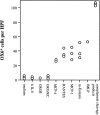Dendritic cells are recruited into the airway epithelium during the inflammatory response to a broad spectrum of stimuli
- PMID: 8976199
- PMCID: PMC2196390
- DOI: 10.1084/jem.184.6.2429
Dendritic cells are recruited into the airway epithelium during the inflammatory response to a broad spectrum of stimuli
Abstract
A key rate-limiting step in the adaptive immune response at peripheral challenge sites is the transmission of antigen signals to T cells in regional lymph nodes. Recent evidence suggests that specialized dendritic cells (DC) fulfill this surveillance function in the resting state, but their relatively slow turnover in most peripheral tissues brings into question their effectiveness in signaling the arrival of highly pathogenic sources of antigen which require immediate mobilization of the full range of host defenses for maintenance of homeostasis. However, the present report demonstrates that recruitment of a wave of DC into the respiratory tract mucosa is a universal feature of the acute cellular response to local challenge with bacterial, viral, and soluble protein antigens. Consistent with this finding, we also demonstrate that freshly isolated respiratory mucosal DC respond in vitro to a variety of CC chemokines as well as complementary cleavage products and N-formyl-methionyl-leucine-phenylalanine. This suggests that rapid amplification of specific antigen surveillance at peripheral challenge sites is an integral feature of the innate immune response at mucosal surfaces, and serves as an "early warning system" to alert the adaptive immune system to incoming pathogens.
Figures


Similar articles
-
Dendritic cell influx differs between the subglottic and glottic mucosae during acute laryngotracheitis induced by a broad spectrum of stimuli.Ann Otol Rhinol Laryngol. 2002 Jul;111(7 Pt 1):567-72. doi: 10.1177/000348940211100701. Ann Otol Rhinol Laryngol. 2002. PMID: 12126010
-
Acute laryngitis in the rat induced by Moraxella catarrhalis and Bordetella pertussis: number of neutrophils, dendritic cells, and T and B lymphocytes accumulating during infection in the laryngeal mucosa strongly differs in adjacent locations.Pediatr Res. 1999 Dec;46(6):760-6. doi: 10.1203/00006450-199912000-00020. Pediatr Res. 1999. PMID: 10590036
-
Regulation of dendritic cell recruitment into resting and inflamed airway epithelium: use of alternative chemokine receptors as a function of inducing stimulus.J Immunol. 2001 Jul 1;167(1):228-34. doi: 10.4049/jimmunol.167.1.228. J Immunol. 2001. PMID: 11418653
-
[Dendritic cells of mucosa and skin: "recruited for vaccination"].Med Sci (Paris). 2007 Oct;23(10):819-25. doi: 10.1051/medsci/20072310819. Med Sci (Paris). 2007. PMID: 17937889 Review. French.
-
Enemy at the gates: dendritic cells and immunity to mucosal pathogens.Cell Res. 2010 Aug;20(8):872-85. doi: 10.1038/cr.2010.94. Epub 2010 Jul 6. Cell Res. 2010. PMID: 20603644 Review.
Cited by
-
The Effects of Dietary Bacillus amyloliquefaciens TL106 Supplementation, as an Alternative to Antibiotics, on Growth Performance, Intestinal Immunity, Epithelial Barrier Integrity, and Intestinal Microbiota in Broilers.Animals (Basel). 2022 Nov 9;12(22):3085. doi: 10.3390/ani12223085. Animals (Basel). 2022. PMID: 36428313 Free PMC article.
-
Dendritic cell activation and cytokine production induced by group B Neisseria meningitidis: interleukin-12 production depends on lipopolysaccharide expression in intact bacteria.Infect Immun. 2001 Jul;69(7):4351-7. doi: 10.1128/IAI.69.7.4351-4357.2001. Infect Immun. 2001. PMID: 11401973 Free PMC article.
-
Mature dendritic cells infiltrate the T cell-rich region of oral mucosa in chronic periodontitis: in situ, in vivo, and in vitro studies.J Immunol. 2001 Oct 15;167(8):4693-700. doi: 10.4049/jimmunol.167.8.4693. J Immunol. 2001. PMID: 11591800 Free PMC article.
-
Phagocytosis of bacille Calmette-Guérin-infected necrotic macrophages induces a maturation phenotype and evokes antigen-presentation functions in dendritic cells.Immunology. 2002 Dec;107(4):500-6. doi: 10.1046/j.1365-2567.2002.01536.x. Immunology. 2002. PMID: 12460195 Free PMC article.
-
Dendritic Cell-Restricted Progenitors Contribute to Obesity-Associated Airway Inflammation via Adam17-p38 MAPK-Dependent Pathway.Front Immunol. 2020 Feb 28;11:363. doi: 10.3389/fimmu.2020.00363. eCollection 2020. Front Immunol. 2020. PMID: 32184787 Free PMC article.
References
Publication types
MeSH terms
Substances
LinkOut - more resources
Full Text Sources
Other Literature Sources

